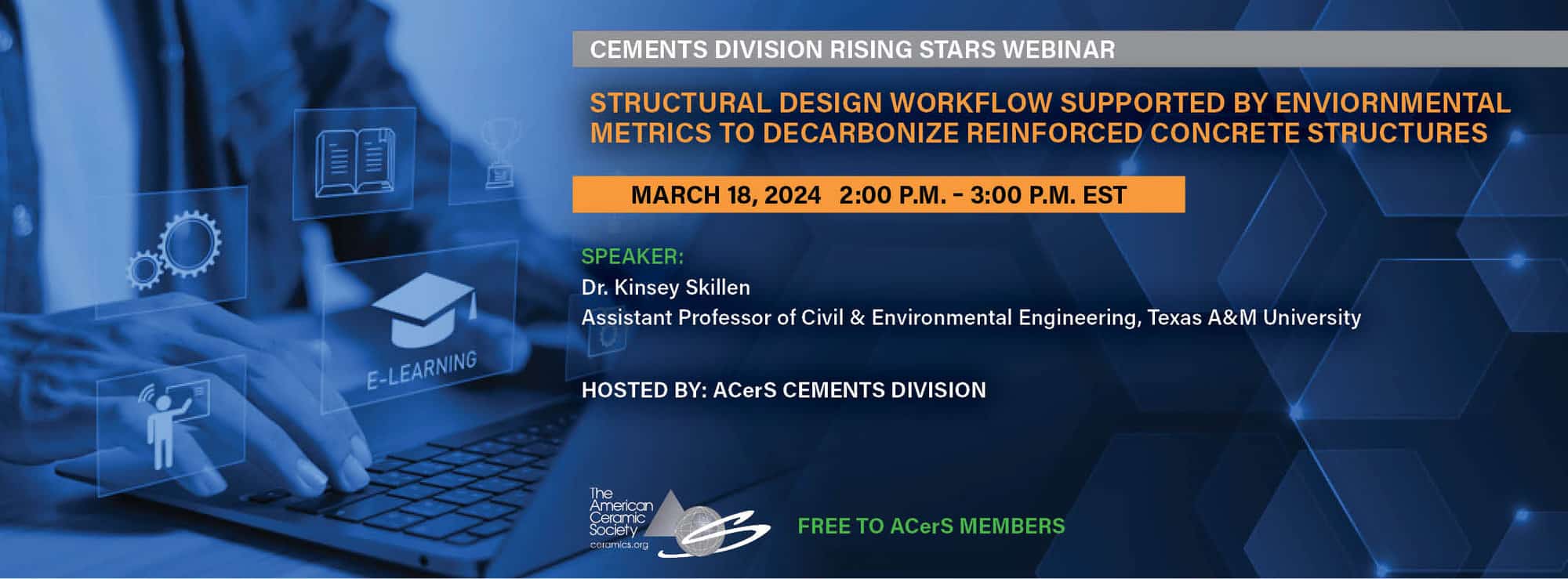
Hosted by: ACerS Cements Division
Due to unforeseen circumstances, this webinar will be postponed to a later date. Details coming soon on new date and time.
Monday, March 18, 2024; 2p.m. – 3p.m. Eastern US time
Sponsored by the ACerS Cements Division, the March webinar will feature one speaker: Structural Design Workflow Supported by Environmental Metrics to Decarbonize Reinforced Concrete Structures
DESCRIPTION
Structural Design Workflow Supported by Environmental Metrics to Decarbonize Reinforced Concrete Structures
Many strategies have been delineated to reduce GHG emissions from the cement and concrete industry, yet optimization of structural design efficiency as a function of material properties is still under-investigated. Strategies focusing on the manufacturing of less carbon intensive cementitious materials may face scalability setbacks due to the risk adverse nature of the construction and design industries. As a result, concrete mix proportioning and structural design optimization have been mostly addressed as two separate challenges rather than a joint optimization problem. This is due to the lack of tools and methods capable of integrating both design domains to maximize the efficiency of reinforced concrete (RC) structures. Such integration requires concurrent optimization of concrete, steel, and geometric constraints as they synergistically drive proportioning of RC structures. Reinforcement and concrete properties have a combined effect in dictating the dimensionality of structural elements and, consequently, dictate cost and carbon footprint of an entire building. As RC designs codes push to adopt sustainability-based design provisions, they must incorporate structural and material interactions, leading to a more informed quantification of environmental impacts. This presentation will center around a reinforced concrete building design example, illustrating the considerable influence of joint optimization on both cost and carbon footprint reduction. These workflow strategies have been incorporated into a proprietary software application, rooted in ACI 318-19 design provisions, are readily applicable for practicing engineers, promising immediate impact and practical implementation.
BIOGRAPHIES

Dr. Kinsey Skillen, Assistant Professor of Civil & Environmental Engineering, Texas A&M University
Kinsey Skillen, PhD is an Assistant Professor of Civil & Environmental Engineering within the Construction, Geotechnical, and Structures Division at Texas A&M University, College Station, TX. He also holds a joint appointment as an Assistant Research Scientist of Major Highway Structures for the Texas A&M Transportation Institute (TTI). He obtained his BSCE from Montana State University in 2015, MSCE from Purdue University in 2017, and PhD in Civil Engineering from Purdue University in 2020.
He conducts large-scale structural testing of bridge and building structures at the Texas A&M Center for Infrastructure Renewals (CIR) Structural Testing Laboratory. His current research focuses on bond and anchorage of hooked and headed reinforcement, accelerated bridge construction, fatigue and fracture of high-mast towers for the Texas Department of Transportation (TxDOT) and topics related to ultra-high- performance concrete for the American Concrete Institute (ACI).
REGISTRATION
Register here.
ACerS member: no cost
ACerS GGRN and Material Advantage student member: no cost
Non-member: $30
Non-member student: $15
If you have any questions, please contact Vicki Evans.
This webinar is brought to you by the ACerS Cements Division.
To view past ACerS webinars click here.
